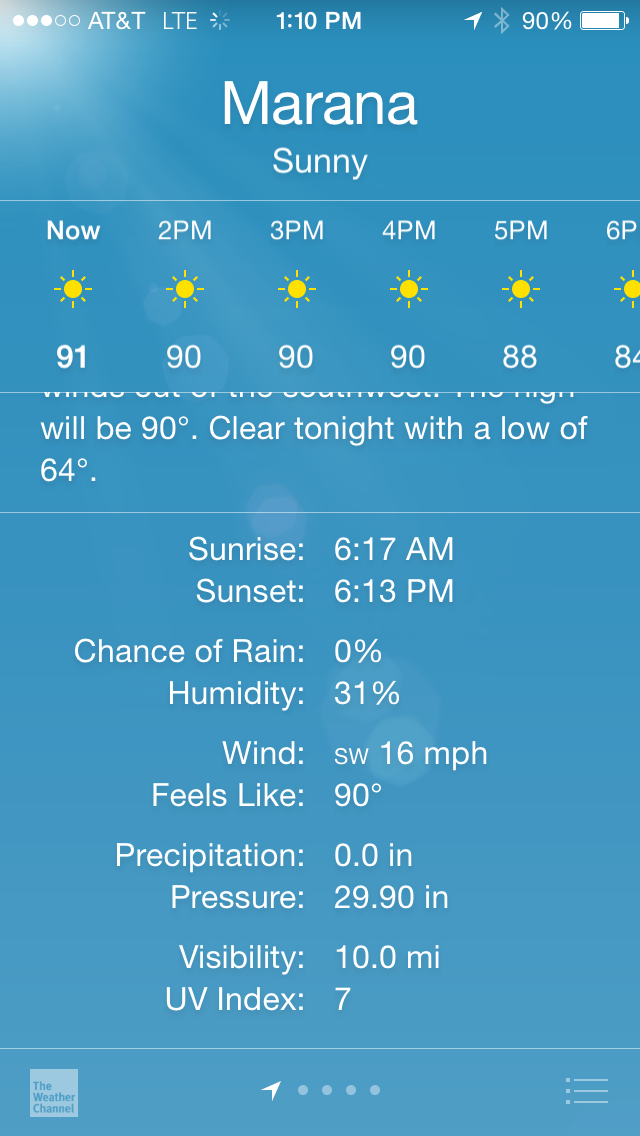iOS 8 Could Save Your Life
With the recent release of iOS 8, Apple is using a different data provider for its built-in Weather app. Next time you pop it open, scroll down to the bottom of the details and take a look at the current UV index for your area. Use this to avoid sunburns — even if it's cloudy!

Our family knows the hell that melanoma is all too well. Use this tool, know when to slap on the sunscreen, and reduce the risk of melanoma in your family!
Here's a guide for interpreting UV levels duplicated from the epa.gov's Sunwise site for your convenience:
2 or less: Low
A UV Index reading of 2 or less means low danger from the sun's UV rays for the average person:
- Wear sunglasses on bright days. In winter, reflection off snow can nearly double UV strength.
- If you burn easily, cover up and use sunscreen.
Look Out Below
Snow and water can reflect the sun's rays. Skiers and swimmers should take special care. Wear sunglasses or goggles, and apply sunscreen with an SPF of at least 30. Remember to protect areas that could be exposed to UV rays by the sun's reflection, including under the chin and nose.
3-5: Moderate
A UV Index reading of 3 to 5 means moderate risk of harm from unprotected sun exposure.
- Take precautions, such as covering up, if you will be outside.
- Stay in shade near midday when the sun is strongest.
Me and My Shadow
An easy way to tell how much UV exposure you are getting is to look for your shadow:
If your shadow is taller than you are (in the early morning and late afternoon), your UV exposure is likely to be low. If your shadow is shorter than you are (around midday), you are being exposed to high levels of UV radiation. Seek shade and protect your skin and eyes.
6-7: High
A UV Index reading of 6 to 7 means high risk of harm from unprotected sun exposure. Apply a sunscreen with a SPF of at least 30. Wear a wide-brim hat and sunglasses to protect your eyes.
- Protection against sunburn is needed.
- Reduce time in the sun between 10 a.m. and 4 p.m.
- Cover up, wear a hat and sunglasses, and use sunscreen.
Made in the Shades
Wearing sunglasses protects the lids of your eyes as well as the lens.
8 - 10: Very High
A UV Index reading of 8 to 10 means very high risk of harm from unprotected sun exposure. Minimize sun exposure during midday hours, from 10 a.m. to 4 p.m. Protect yourself by liberally applying a sunscreen with an SPF of at least 30. Wear protective clothing and sunglasses to protect the eyes.
- Take extra precautions. Unprotected skin will be damaged and can burn quickly.
- Minimize sun exposure between 10 a.m. and 4 p.m. Otherwise, seek shade, cover up, wear a hat and sunglasses, and use sunscreen.
Stay in the Game
Be careful during routine outdoor activities such as gardening or playing sports. Remember that UV exposure is especially strong if you are working or playing between the peak hours of 10 a.m. and 4 p.m. Don't forget that spectators, as well as participants, need to wear sunscreen and eye protection to avoid too much sun.
11+: Extreme
A UV Index reading of 11 or higher means extreme risk of harm from unprotected sun exposure. Try to avoid sun exposure during midday hours, from 10 a.m. to 4 p.m. Apply sunscreen with an SPF of at least 30 liberally every 2 hours.
- Take all precautions. Unprotected skin can burn in minutes. Beachgoers should know that white sand and other bright surfaces reflect UV and will increase UV exposure.
- Try to avoid sun exposure between 10 a.m. and 4 p.m.
- Seek shade, cover up, wear a hat and sunglasses, and use sunscreen.
Beat the Heat
It is possible to go outside when the UV Index is 11 or higher. Make sure you always seek shade, wear a hat, cover up, wear 99-100% UV-blocking sunglasses, and use sunscreen. Or you can opt to stay indoors and take the opportunity to relax with a good book rather than risk dangerous levels of sun exposure.
What about you?
Have you ever been burned when you didn't expect it? Need sunscreen advice?